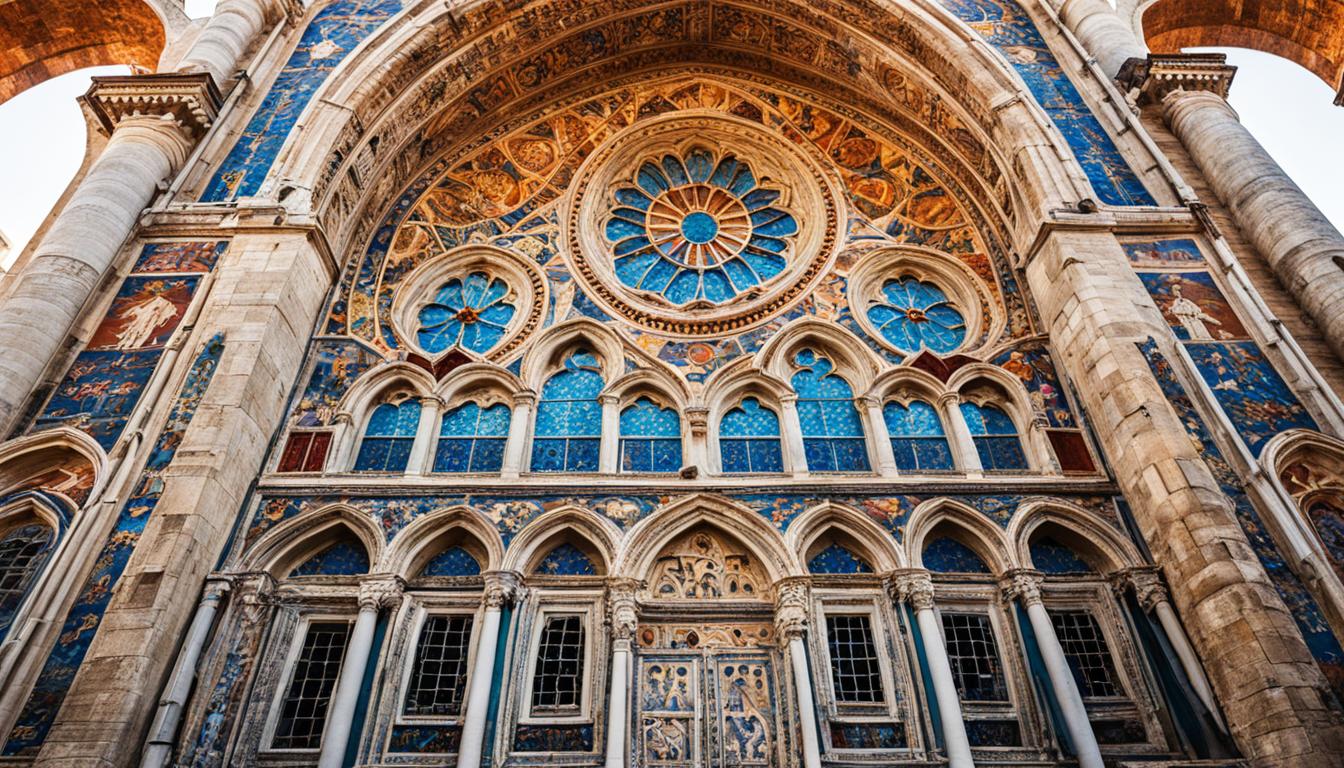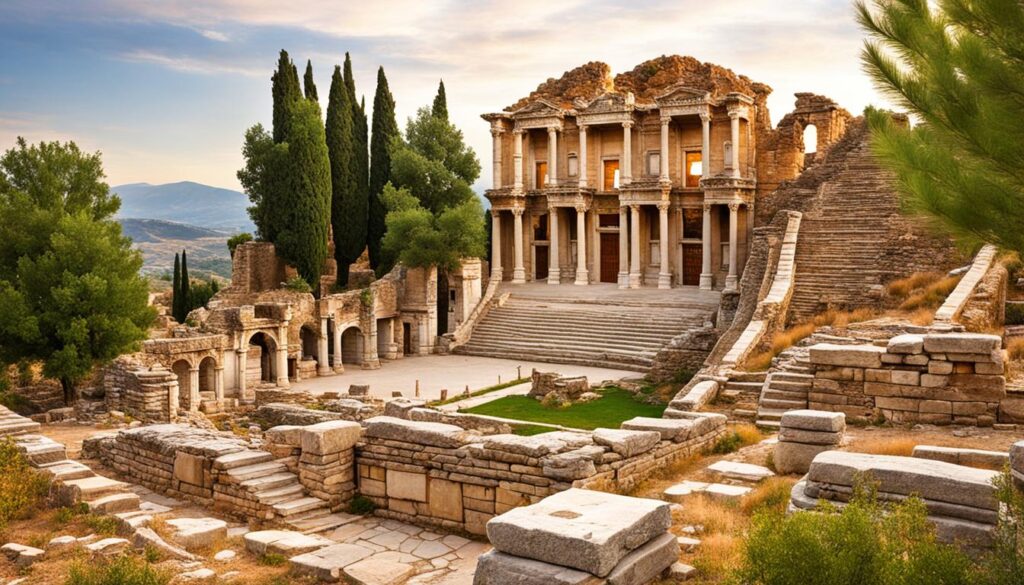
Explore The Top 7 Historic Churches in Turkey
Starting a Christian pilgrimage to historic churches in Turkey is not just a trip. It’s like diving into a deep spiritual adventure that has lasted for ages. These holy places in Turkey tell a story of faith woven into the country’s culture. They call to pilgrims and history lovers.
The power of faith in these Turkish churches is strong. You can feel it in the air, as every stone seems to whisper ancient hymns and prayers. Exploring Turkey’s ancient churches takes you from grand Byzantine domes to simple cave chapels. It’s a chance to walk in the footsteps of the first Christians and see where their spiritual journey began.
Unraveling the Byzantine Legacy: Delving into Turkey’s Ancient Places of Worship
Turkey is filled with historical wonders and areas of worship, thanks to the Byzantine era. Ancient churches in the country show a deep Christian heritage. These sites draw visitors from all over, showing them history and faith.
The Significance of the Seven Churches of Revelation
The Seven Churches of Revelation are found in Western Turkey. They mark the early spread of Christianity in Anatolia. For scholars and devout followers, these places are key. They hold stories of biblical significance.
Byzantine Architecture and Its Influence on Religious Sites in Turkey
Byzantine architecture is known for its majestic domes and detailed mosaics. It greatly influences Turkey’s sacred sites. For example, the Hagia Sophia and the Chora Church show off this style’s beauty. These ancient churches embody a rich history and aesthetic brilliance.
Religious Tourism and its Impact on Turkey’s Historic Churches
Religious tourism helps protect Turkey’s historic churches. It brings economic support and awareness. This keeps these landmarks preserved for future visitors. It also lets people from different cultures learn about Turkey’s Christian heritage. Tourists connect with the history and spirituality of these places.
Churches in Turkey: A Testament to the Nation’s Christian Heritage
Turkey is at the crossroads of east and west. This offers a deep look into its Christian heritage through its ancient churches. The beauty of Anatolia tells stories of faith and art. Each church is a story in Turkey’s religious history. Visit religious sites in Turkey to see Byzantine mosaics. Hear the ancient prayers echoing within these sacred places.
These buildings are more than stone and mortar. They are symbols of spiritual history. The churches in Turkey are diverse. Consider Istanbul’s Hagia Sophia with its stunning domes. Or the ruins of Antioch’s church caves, filled with history. Each site guards the Christian heritage of this land.
- The Cave Church of St. Peter in Antakya, a place where early Christians gathered. It is carved out of mountain stone.
- The Monastery of Mor Gabriel in Mardin, a symbol of Syriac Orthodox Christianity. It stands tall in the Mesopotamian plains.
- The Aya Nikola Church on Gökçeada, rich in history and legend. Centuries of worship have touched its walls.
Exploring these ancient churches is a journey back in time. It connects us with Turkey’s Christian heritage. Each structure tells a story of the faithful. The art and architecture show how Christianity evolved here. The experience fills explorers with curiosity, reverence, and awe at these religious sites in Turkey.
“To walk amidst these ruins is to hear the melodies of bygone liturgies. It is to witness the enduring spirit of Turkey’s Christian ancestors – a true story of faith set in stone.”
A Guide to Ephesus: Tracing the Steps of Saint John and the Virgin Mary
Ephesus is a city known for its rich Christian history. It invites visitors to explore its paths once walked by Saint John and the Virgin Mary. This guide highlights the spiritual importance of Ephesus, combining archaeological discoveries with holy stories. It connects visitors to the early days of Christianity.

The Historical Church of Ephesus and the House of Virgin Mary
In the green hills of Selçuk, the Church of Ephesus ruins still stand. These ruins remind us of the city’s religious past. Here, you can feel the echoes of Saint John’s messages. Not far away, the House of Virgin Mary offers peace in nature’s embrace. This simple home shows Mary’s humility and faith, providing a quiet spot for prayer.
Archaeological Insights from the Ruins of Saint John’s Tomb
The Saint John’s Tomb ruins offer valuable archaeological findings. They tell stories of religious passion and historic beauty. As visitors explore, they feel connected to the apostle’s life and the shift to Christianity. The efforts to uncover these ruins help bring ancient Ephesus to life. They offer a unique view into Christianity’s beginnings.
“Ephesus does not solely belong to the past; it is a beacon that continues to guide the spiritual journeys of many, charming them with its enigmatic ruins and sacred precincts.”
| Site | Historical Importance | Religious Significance |
|---|---|---|
| Church of Ephesus | Once a central hub of early Christian community | Believed to be the site of Saint John’s Gospel composition |
| House of Virgin Mary | A revered Christian and Muslim shrine | Considered the final abode of Mary, Mother of Jesus |
| Saint John’s Tomb | Archaeological wonder rich with early Christian artifacts | Sacred to the memory of Saint John the Apostle |
The stories of Ephesus, Saint John, and the Virgin Mary still inspire us today. As we explore these ancient stones, we connect with early Christianity’s spirit. The insights we gain from Ephesus enrich our understanding of the past. They guide us in shaping our present and future.
The Intersection of Culture and Faith at Smyrna: Modern İzmir’s Religious Landmark
Smyrna, now called İzmir, is a place where different beliefs meet. It is a cultural intersection. This city tells stories of a past where myths and monotheistic religions mixed. It draws those curious about the blend of culture and faith.
In its old streets and lively markets, İzmir remains an important religious landmark. People from all over come to see its holy places. Here, ancient temples, mosques, and churches stand together. They show İzmir’s commitment to spiritual diversity and openness.
Exploring İzmir shows its importance in early Christianity. The remains of the Smyrna church tell of its deep biblical history. This site is more than just ruins. It is a story carved in stone, inviting us to reflect on how devotion has changed over time.

| Landmark | Tradition | Historical Era | Cultural Influence |
|---|---|---|---|
| Agios Voukolos Church | Christianity | Byzantine | Christian Heritage of İzmir |
| Kadifekale Castle | Pagan | Hellenistic | Greco-Roman Mythology |
| Kemeraltı Bazaar Mosque | Islam | Ottoman | Ottoman Architecture |
| Synagogue Street | Judaism | Sephardic | Jewish Diaspora |
İzmir’s spirit as a cultural intersection shines during its festivals. These events honor the city’s mix of faiths. From Orthodox Easter to Ramadan, every tradition is celebrated. This shows İzmir’s lasting message of peace and unity. Read about mosques in turkey also.
Journey through Pergamon: The Struggle Between Christianity and Paganism
The ancient city of Pergamon is a witness to the shift of religious beliefs. Its buildings tell the story of Christianity and Paganism meeting. This site is much more than old ruins; it shows how different beliefs lived side by side. It captures a time when gods and a rising Christian faith existed together.
Exploring Pergamon’s Architectural Splendors and Christian Sites
Pergamon is filled with ruins from many times, showing its rich history. Here, visitors can see the Great Altar and old pagan temples. They can also find places where early Christians met quietly, challenging the main Pagan beliefs.
The Acropolis of Pergamon stands out for its stunning views. This site had theaters, temples, and libraries showing its culture and belief. These places show the city’s mix of knowledge and faith long ago.
The Religious Paradox: Christian Faith Amidst a Pagan Past
In Pergamon, early Christians faced a big challenge. They lived in a city known for worshipping Zeus and Asklepios, yet their faith grew. This shows how Christianity spread in a place full of Pagan beliefs. Their determination is a story of hope, as their belief stood firm against old Pagan practices.
| Pergamon’s Pagan Heritage | Christian Developments |
|---|---|
| Temple of Trajan | The Red Basilica (Church) |
| Temple of Dionysus | Christian Inscriptions and Relics |
| Asklepieion (Healing Temple) | Christian Communal Gathering Spots |
| Altar of Zeus | Adapted Pagan Site as Christian Worship Spaces |
Today, Pergamon is like an open museum, leaving a lasting mark on visitors. It shows how two different cultures can come together and learn from each other. The story of Pergamon offers a deep look into how religions can evolve over time.
Conclusion
Going to ancient churches in Turkey is more than just traveling. It’s like stepping into a world where the holy ground and tall steeples tell stories of faith and bravery. This spiritual journey lets you see the beauty of Byzantine architecture up close. It invites you to connect with the sacred prayers that have filled these places.
Walking where early Christians walked, you feel a deep link to history and the divine. The religious heritage of Turkey can be seen in every stone and painting in these old buildings. From the famous Seven Churches of Revelation to the sanctuaries in Istanbul with beautiful mosaics, traveling through the country shows you a collection of religious sites. Each site tells its own story.
These places are still used for worship and studying history, giving us a chance to learn about Christianity’s start and growth in the area. At the end of our travels, we discover the real heart of Turkey’s Christian history in the quiet solemnity of these holy places. The ancient churches are more than monuments. They are reminders to think about our cultural and spiritual identity that shapes our world today.
This journey, full of learning and respect, shows the lasting strength of faith. It shows how the human spirit continues to overcome challenges over time.
FAQ
What is the significance of the ancient churches in Turkey?
The ancient churches in Turkey are very important. They show Turkey’s Christian past and are known for their beautiful Byzantine art. These churches were key in spreading Christianity in the area. They are also major spots for Christian visitors and tourists.
What is Byzantine architecture and how does it influence religious sites in Turkey?
Byzantine architecture started during the Byzantine Empire. It’s famous for big domes and detailed decorations. This style has shaped Turkey’s religious sites into unique and stunning places. The ancient churches in Turkey are great examples of Byzantine architecture.
How does religious tourism impact the historic churches in Turkey?
Religious tourism helps keep Turkey’s historic churches open and in good shape. These churches attract tourists and pilgrims worldwide. The money from tourism supports the upkeep of these old churches. This lets future generations enjoy and learn from them.
What can I expect to find when visiting the ancient churches in Turkey?
In Turkey, you’ll see many different styles and stories in the ancient churches. From small ones in villages to big cathedrals, every church tells its own story. You’ll get to learn about Turkey’s Christian past. You’ll also see the amazing Byzantine art and feel the peace in these holy places.
Are there any significant religious sites in Ephesus?
Yes, in Ephesus, you’ll find the important Church of Ephesus, a key Christian site. Another sacred place is the House of Virgin Mary, believed to be where Mary spent her last days. You can also see Saint John’s Tomb, offering a peek into early Christian history in Ephesus.
What cultural and religious landmarks can I explore in Smyrna (İzmir)?
İzmir, once called Smyrna, is rich in culture and faith. You can visit the city’s religious landmarks and learn their stories. Thanks to its mixed heritage, İzmir has a lively mix of traditions. This adds to the city’s religious scene. There, you’ll find various sacred sites and landmarks for a unique spiritual journey.
What is the religious paradox of Pergamon?
Pergamon, an old city, was known for its great buildings and the mix of Christianity and Paganism. The religious paradox in Pergamon shows how Christianity and Pagan worship existed together. Visiting Pergamon, you can see how early Christians lived among Pagans. You’ll also admire the architecture and Christian sites there.
Source Links
- https://goturkiye.com/blog/seven-churches-of-revelation-in-turkiye
- https://www.istanbulturkeytravel.com/7-churches-of-revelation-turkey/
- https://www.thrillophilia.com/sacred-places-in-turkey

Leave a Reply